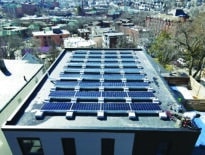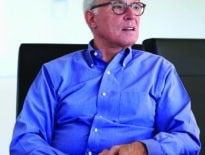
Waves pushed by Tropical Storm Henri hit a breakwater on Cape Cod on Aug. 22. Experts predict Cape Cod and the Islands are at significant risk from rising seas and stronger storms thanks to climate change.
With New England facing projections of a dire future as the planet warms, local lenders are coming face to face with the need to adapt to new risks.
The latest report from the United Nations Intergovernmental Panel on Climate Change confirmed that global warming continues to intensify, putting places like Cape Cod and the Islands on the front line. A recent report from The Trustees estimates about 900 buildings on Martha’s Vineyard and Nantucket alone are at risk of daily tidal flooding in the next 10 to 20 years thanks to sea level rise. At the same time, storms made stronger by climate change – like the tropical storm that nearly hit the area last week – are putting hundreds of acres of coastal land at risk of erosion, the report said.
“We look at [climate change] in terms of the risks to families, businesses, visitors, and – particularly with the Cape and the Islands – it also becomes an economic issue for us given that economic drivers for our region are focused a lot on tourism, second homes and folks wanting to visit because of the beauty of the area we’re in,” said Matthew Burke, co-president of Cape Cod Five. “But with that also comes susceptibility and some big risks associated with … rising sea levels, storms, flooding.”
Physical Risks Prominent
In the face of forecasts like these, bank regulators are starting to explore the effects of climate change on the banking industry. The Federal Reserve Board began developing a framework earlier this year to understand the impact climate change could have on the broader financial system, and the Office of the Comptroller of the Currency named its first climate change risk officer in July.
Large banks face balance sheet risks from financing polluting sectors such as energy and transportation that could be hurt by the transition to clean energy. Community banks and credit unions, however, operate in sectors that could be physically affected by climate change, including residential mortgage, commercial real estate, small business and agriculture lending, said Dan Saccardi with Ceres, a Boston-based nonprofit that examines sustainability challenges, including in the financial sector.
Physical branches themselves could also be at risk, said Saccardi, the senior director of Ceres’ company network.
“By the nature of being a community bank or credit union, they tend to be more geographically concentrated, such that if there were a major weather event – flooding, storm, fire – that is severely impacting a community that a community bank or credit union is largely operating in, they wouldn’t be able to diversify away some of those severe economic impacts – to say nothing of the physical and environmental and human toll,” he said.
However, community banks and credit unions lack the resources that global banks can put toward climate modeling, putting in place adaptations and helping clients prepare for climate change.
Many large banks have been developing frameworks for assessing their climate change risks. The global Task Force on Climate-Related Financial Disclosures, created by the Financial Stability Board, released recommendations in 2017 to guide companies on how to assess their risks and provide this information to investors. The FSB reported last year that about 1,500 companies have supported the initiative. PNC endorsed the recommendations in 2019 and this month released its first report describing the framework it is developing to make disclosures.
Small Lenders Face Resource Limits
There are steps that even smaller institutions can take, Saccardi said, even if they don’t have the resources of a global or regional bank.
“Before you can fully gauge the exposure that you might be facing, you have to do some of the work to measure that,” Saccardi said.
Rather than starting from scratch, he said, banks and credit unions could collaborate with firms in other industries, such as insurance, to capitalize on the work they have already done to understand future risks from flooding, storm surges and droughts by ZIP code, Saccardi said. He added that regulators could also have a role in providing resources and guidelines to help community institutions get started on understanding the risks.
These efforts will also help put financial institutions in a position to in turn aid their own clients, including mortgage borrowers and small businesses, minimize their own exposures.
“The more that [banks and credit unions] can understand the current landscape and future projections, the better they can understand where they can shore up their own physical assets,” Saccardi said. “But more importantly, work with their clients to make those clients’ operations as resilient as possible to some of these physical impacts.”
Lender Sets Strategic Goal
For Cape Cod Five, what the bank calls “environmental stewardship” has become a cross-cutting goal that affects all strategic decisions at the bank, Burke said.
“It’s tough for us to make any decision looking from a strategic standpoint without taking that into consideration,” Burke said. “How can we be part of the solution supporting and sustaining what is a fragile environment that we’re in? One thing isn’t going to solve it.”

Diane McLaughlin
Residential mortgage lending is one product that has been affected by climate change, with considerations around flood insurance growing in significance. While not rejecting more loans, Cape Cod Five works with borrowers on questions about whether they want to buy in a flood zone, Burke said, and the effects of flood insurance on the overall cost of owning a home. He added that the effect of flood insurance on the cost of homeownership factors into underwriting.
Many of the worst aspects of climate change could play out 10 to 30 years in the future, Burke said, forcing the bank to try and anticipate how current risks will evolve.
But risk mitigation involves not just considering the problems, Burke said, but also contributing to solutions that help address the causes of climate change, like financing solar panel developments. Cape Cod Five CEO Dorothy Savarese also represents the bank on the board of the Cape Cod Climate Change Collaborative, a group of business and community leaders that advocates in favor of climate change mitigation projects and renewable energy.
“We live and die by the region that we’re in; we’re inextricably tied and linked to the sustainability of our environment,” Burke said. “We look at it as, how can we be a leader, how can we partner with our customers and communities to be a part of the solution [and] build a more resilient region.”






